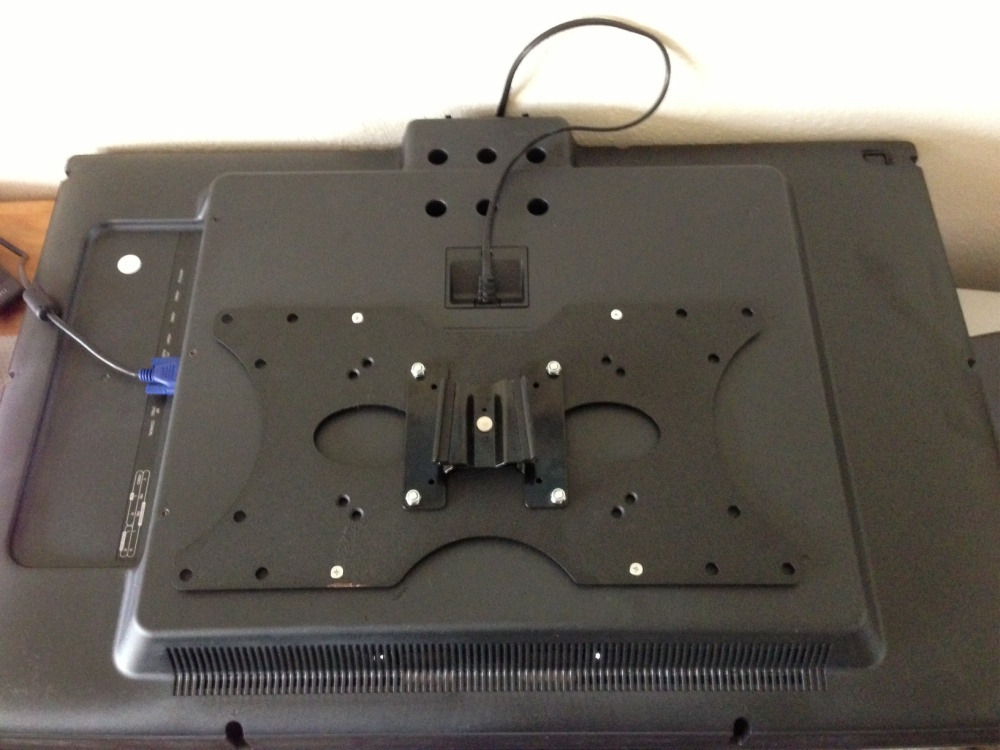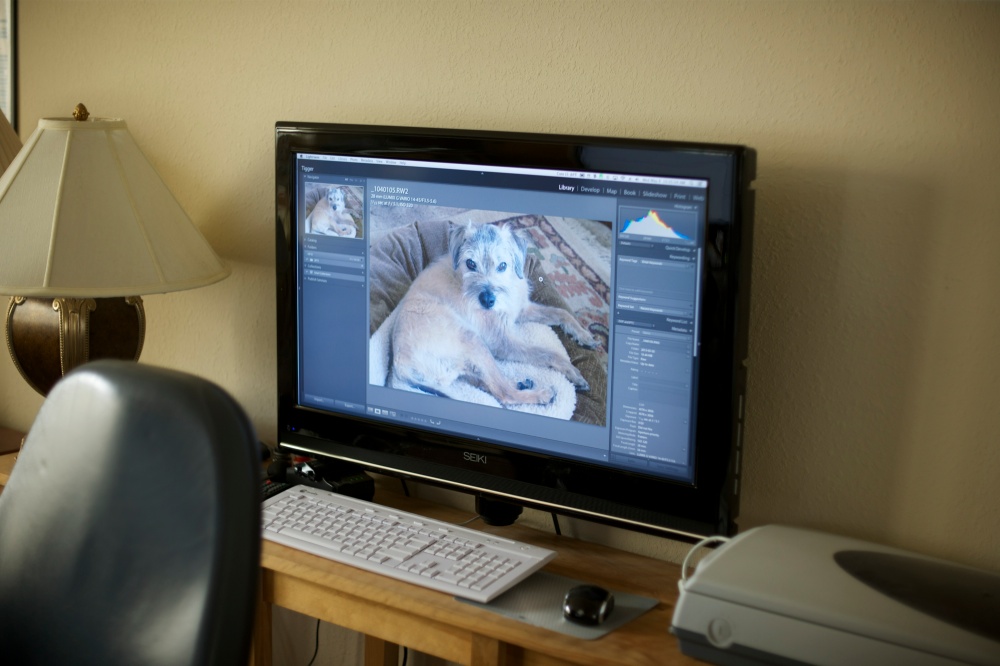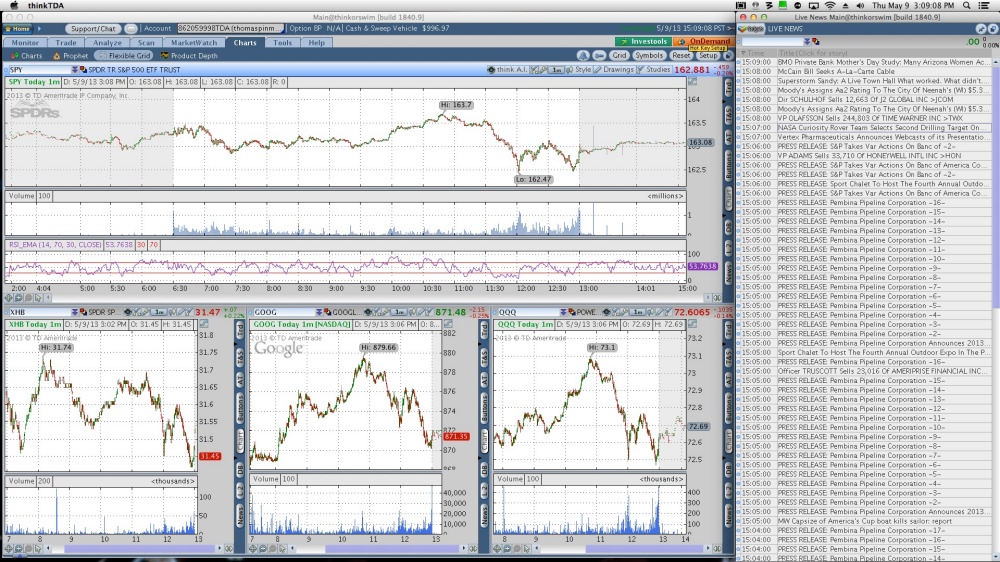All of 32″!
When I asked ace computer builder and Hackmeister FU Steve to put together an economy Hackintosh for me some 18 months ago, the uses and design dictates were simple. The prime use for the machine would be to provide streaming stock quotes and related data feeds on two 21.5″ displays as well as acting as a backup in the event something went wrong with my main desktop machine, the nuclear powered, state-of-the-art HP100+. Accordingly the economy HP10 sports a Sandy Bridge i3 CPU, a second-hand nVidia 9800GTX+ GPU and a couple of regular spinning disk hard drives, each a modest 500GB.
The machine has proved excellent and is running OS Mountain Lion 10.8.3, the current version of the best OS on the planet.
The other day, when upgrading the living room TV from 42″ to 55″, I remarked how inexpensive large CD displays were becoming, and that triggered the idea to swap the HP10’s two smallish monitors for one big one. The cheapest 32″ LCD (actually 31.5″) I could find at Amazon was the Seiki LC-32G82 for $220, delivered from Adorama in NYC. Since then I have discovered that Kmart in the Bay Area peninsula stocks the same set for the same price, and I would counsel buying locally as QC with these cheap Chinese sets seems iffy. A local purchase makes exchange easier.
The screen area of a 31.5″ set is 215% that of one 21.5″ display, so the total screen space is largely unchanged, but in a much more elegant setup. Proceeds of sale of the old displays will pay for the new.
I wall mounted the set – it only weighs 29 lbs, using one of the original 100mm VESA mounts bolted to a $10 adaptor plate, the mount attached to the wall via a batten which is bolted with lug bolts to the studs in the wall. The distance from screen to wall is a total of 7 inches, and the surface is semi-matt, posing no issues with reflections.

Adapter plate for original VESA mount installed. Pillar for supporting plate has been removed, top.

On the wall. Pillar for supporting plate visible underneath, not yet removed.
While the display will be used exclusively for my day job, I took a moment to test it with Lightroom to determine whether it could be used for photo processing. First I tried a Mini DisplayPort to HDMI connector then a DVI-A to VGA one. Surprisingly, the VGA connector rendered considerably higher resolution so that’s what I am using. VGA, an analog feed, is not supported by EyeOne’s Display One software and colorimeter, so I profiled the display using Apple’s excellent utility (in Expert mode) found in Sys Prefs->Displays->Color, with final fine tuning done by eye against one of my calibrated Dell 2209WA monitors attached to the HP100+.
The results are really excellent and I illustrate this below, first with a JPG exported from LR on the HP100+:

Next is a screenshot of the same image on the calibrated Seiki:

Judge for yourself.
So the Seiki is more than usable as a very cost-effective large display for processing images. 32″ for photo processing is really large so your workspace really needs a decent setback so that your nose is not in the display, but after a few minutes use there’s no going back.
What are the drawbacks?
Well, it’s not as elegant as a big Dell Ultrasharp, sporting a relatively broad, glossy bezel. Though it’s only 60HZ that is fine for watching fast moving sports like Formula One through BBC’s iPlayer. By contrast, the same sport viewed on any of my three Dell 2209WA displays is poorly rendered, with much smearing/doubling in full screen mode. At this point I’m beginning to wonder why I spent $1,000 on the three Dell monitors …. The Seiki is 1920 x 1080 (16:9 widescreen), not the higher resolution 2560 x 1600 (16:10 – much nicer) sported by the Dell. And the warranty is one year compared to three. Wake from sleep is some 20 seconds, compared to 1 second for my Dells if that’s of concern.
On the other hand, the current Dell 3014 runs $1,300, so you could get almost six of the Seikis for one Dell. And you can dispense with separate computer speakers or a sound bar as if you are using VGA with a green motherboard socket, a separate 3.5mm coax cable delivers sound through the Seiki’s built in speakers which are quite decent sounding.
It’s an enticing proposition for photographers on a budget. If you decide on one, be sure not to get the $20 cheaper 720p version. That’s false economy. The correct model designation is LC32G82. While you can pay many times the amount asked for slimmer, more chic-looking sets, the finish of the Seiki is first class with tight seams and no blemishes on my example. The stand is very sturdy and the massive support pillar easily removed (six screws), replaced by a supplied blanking plate for wall mounting.

Easily read on a 32″ display. Click the image for a larger version of this Seiki screenshot.
Oh! and one other thing. You can always watch the TV on this display!